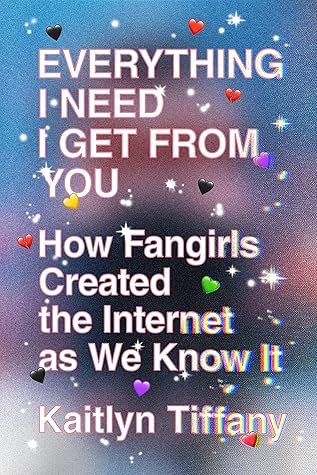More on this book
Community
Kindle Notes & Highlights
Read between
September 10 - September 13, 2022
Yet a fangirl still exists in contradiction to the dominant culture. She’s not considered normal or sane; her refusal to accept things the way they are is one of her defining characteristics. She is dropping out of the mainstream even while she embraces a thing that is as mainstream as a thing can get.
Stanford University artificial intelligence researcher Paul Martin created the distribute command “dead.dis@sail” to collate his lab’s email conversation about the Grateful Dead into a proto listserv. In early 1975, he made the mailing list semipublic by putting it on ARPANET—the U.S. Department of Defense’s experiment in communication protocols that would eventually lead to the invention of the internet as we know it—and researchers from other universities started joining.5 Martin programmed automatic news updates that crawled for information about the Grateful Dead and sent them out
...more
Fans became, almost as a rule, the first to adopt new platforms and to invent new features of the internet—a habit molded by the fact that they were the people with the most obvious incentive to do so.
Before most people were using the internet for anything, fans were using it for everything.
“Girls and women are a substantial presence on the World Wide Web,” the researcher Pamela Takayoshi wrote in 1999, bucking the general assumption—it was just that the sites they were building occupied “a nonmainstream, nondefault position” and were going unnoticed.
With Instant Acolytes’ inclination to go online from home and for fun, the Internet may be evolving much like the telephone into a domestic tool for sociability used more heavily by women. Rather than a mysterious technology that is the province of men, the Internet is on the cusp of becoming a household appliance whose applications are as much social as transactions-oriented.19
“Tumblr, especially in the early days, seemed impenetrable, ruled by a code and norms that were never outlined anywhere officially, only intuited,” Cho writes. “[It] feels almost as if it purposely gave the middle finger to established conventions of indexing, search, and persistence on the internet.”24
WELL cofounder Stewart Brand was the first to refer to as a looming “digital dark age,” when cultural history that is maintained only at will by for-profit corporations erodes and falls away, leaving huge gaps in future generations’ understandings of who we were.
As Nancy K. Baym and Jean Burgess document in Twitter: A Biography, the words we associate with Twitter today and use—for better or worse—in regular conversation, like “hashtag” and “don’t @ me,” were not the developers’ own ideas but instead those of early enthusiasts.
The cultural anxiety around popular culture at the time—which has relaxed now, even if it hasn’t totally disappeared—was that it was a homogenizing force that turned every participant into a mindless consumer. But in speaking to hundreds of fans, Cavicchi found something different. These people were exploiting the ultra-popular things they loved in order to become more completely themselves.
Fanning is the dominant mode of online speech, and the vitriol of defensive fans is the dominant mode of shouting people down on social platforms.
Fandom could “easily be accommodated” in the home, and had a low barrier to entry—anybody with a bedroom, a record player, access to magazines and to a social circle of similarly interested girls could participate. It was low-risk, and though it was set up around highly manufactured pop acts and commercial products, it was low supervision and therefore freeing. The theorists called it “a meaningful reaction against the selective and authoritarian structures which control the girls’ lives at school.”
The way that the media describes fans “tends to go from one extreme to the other,” she said. “It’s either hormonal oversexed teenagers to the polar opposite, Oh, they’re politically savvy! They’re activists! That doesn’t capture the culture or the fandom any more than the derisive or derogatory take.” Though, of course, many K-pop fans were participating sincerely in the Black Lives Matter movement, Morimoto felt it was somewhat overlooked that this was “an event that made particularly good use of skills that they happened to have, because they’re cultivated within that fandom.” It didn’t mean
...more
There have been so many calls for empathy, inspection, and nuanced understanding on behalf of the angry men the internet has raised, but there have been far fewer for the fangirls whose beliefs are far more convoluted. They’ve been dismissed and despised, and now they’re exalted, but they have yet to be taken seriously.
for context about subcultural and fandom studies, I read and benefited from Matt Hills’s Fan Cultures, Katherine Larsen and Lynn S. Zubernis’s Fangasm: Supernatural Fangirls, Rob Sheffield’s Dreaming the Beatles: The Love Story of One Band and the Whole World, Gretchen McCulloch’s Because Internet: Understanding the New Rules of Language, and Zoe Fraade-Blanar and Aaron M. Glazer’s Superfandom: How Our Obsessions Are Changing What We Buy and Who We Are, as well as Hop on Pop: The Politics and Pleasures of Popular Culture, edited by Henry Jenkins, Tara McPherson, and Jane Shattuc; Girl Wide
...more


